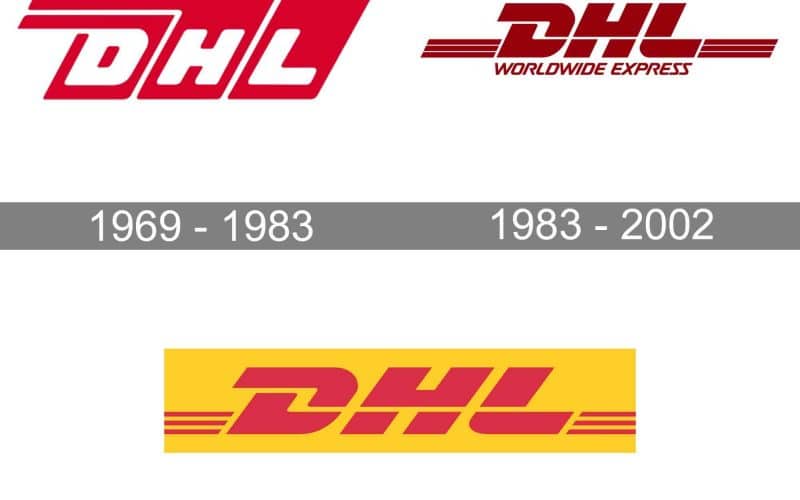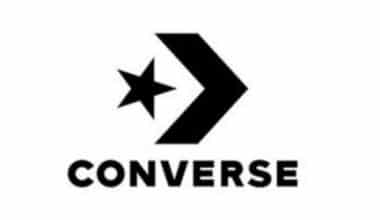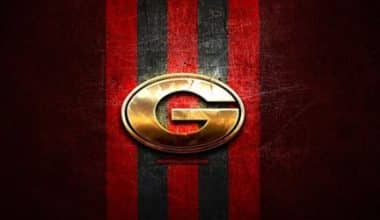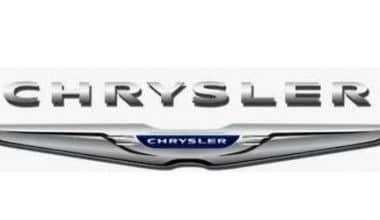The DHL logo has changed from red with white cursive letters to a more upscale graphic style, giving the company a fresh new image. DHL is a well-known delivery company. Despite having a modest beginning, DHL has grown to become a major player in the world of logistics. In this article, we review DHL’s beginnings and historical development. Find out more about DHL’s history and its logo.
Overview of the DHL Logo
The DHL logo comprises its company name, DHL. These are the initials of the last names of the company’s founders, Adrian Dalsey, Larry Hillblom, and Robert Lynn. Long horizontal stripes and the type work together to convey speed. Since it has been focusing on express shipping since 1969, DHL portrays itself as an international delivery service.
To accentuate the letters and give the logo more life, the designers bolded and emphasized them. They did this by utilizing a special typeface created especially for DHL and based on typefaces from the Minion and Frutiger families. It blends broad serifs, robust geometric symmetry, and rounded corners (all denoted by the letters “D,” “H,” and “L”).
The abbreviation is divided by two yellow lines. All the inscriptions are red (Pantone 200), which made it easier to differentiate them from other elements’ backdrops. The underlay is similarly bright yellow (Pantone 116), as are the three stripes below the word “EXPRESS.” This particular color scheme wasn’t always in use. The original logo was red and white, then, from 1983 to 2002, it was maroon.
The Evolution of the DHL Logo
Every brand’s logo changes once in a while, and DHL is no exception. Although the brand name has maintained its distinctive look, the design of individual components and the color scheme has undergone significant alterations.
#1. DHL Logo: 1969 – 1983
The company name is given a distinct space on the original symbol, with each letter contained within its polygon. The heights of geometric forms vary, and they have a small right tilt. Three broad lines at the top of the image give it movement.
#2. DHL Logo: 1983 – 2002
In 1983, DHL entered the domestic US market to launch its delivery. A new logo was unveiled simultaneously with this expansion.
By adding a broad serif to the letter “D,” the designers have changed the font’s appearance. To indicate the company’s area of expertise, the term “WORLDWIDE EXPRESS” was added under the acronym DHL. The big rectangles have been eliminated, and the upper stripes have been copied and positioned to the right and left of the lettering.
#3. DHL Logo: 2002 – present
Deutsche Post AG acquired the logistics business in 2002. It debuted the logo, created by the branding agency Nitsch Design, as a part of DHL Express. The design team preserved most of the prior logo but changed the color to red and encased it in a yellow rectangle. The italicized red word “EXPRESS” is positioned above three yellow lines at the bottom.
Color Codes for DHL Logo
Over the years DHL has changed the color of its logo several times and these colors include:
- Red Corsa
- Color code #d40511
- RGB: 212 5 17
- CMYK: 0 98 92 17
- PMS Bright Red C, Pantone
- Orange Yellow
- Color code: #ffcc00
- RGB: 255 204 0
- CMYK: 0 20 100 0
- PMS 7549 C Pantone
Who Designed the Logo?
Deutsche Post AG acquired the logistics business in 2002. It debuted the logo as a part of DHL Express, which was created by the branding agency Nitsch Design.
What Is DHL?
DHL is a German logistics company. It offers express mail, package delivery, and courier services as a part of the German logistics company Deutsche Post. It sends out more than 1.8 billion packages annually. DHL Express is Germany’s primary courier and package provider and also dominates the European parcel services industry.
The DHL company’s primary segments include
- Express
- Supply post chain
- eCommerce – Parcel delivery
- Global forwarding and freight.
DHL’s slogan is “excellence, relative, and simple delivery.”
What Is the Full Meaning of DHL?
DHL got its name from the initials of the last words of its founders, Dalsey, Hillblom, and Lynn respectively.
Is DHL a Chinese Company?
DHL is a German logistics company though their network extends from China to every nook and cranny of the United States. They can deliver your orders from China to your clients’ doorsteps.
History of DHL ( How it all Began: The Origin)
In the late 1960s, Larry Hillblom obtained a position as a courier for the insurance firm Michael’s, Poe & Associates. At the same time. he was also a law student at the University of California, Berkeley’s Boalt Hall School of Law (MPA). He began serving as a courier between Oakland International Airport and Los Angeles International Airport, delivering packages for the final flight of the day and returning on the first flight the next morning, up to five times per week.
Hillblom and MPA salesman Adrian Dalsey discussed how to bring the company’s speedy delivery philosophy to other commercial organizations after Hillblom received his degree. They transported bills of shipping for their first customer, Seatrain Lines while flying between Honolulu and Los Angeles.
Hillblom invested some of his student loan money in the business, enlisting his friends Adrian Dalsey and Robert Lynn as partners, and naming it after the initials of their last names (DHL).
They traveled about San Francisco in a shared Plymouth Duster to collect the paperwork in their luggage.
They then hurried to the airport to book flights using a different, relatively recent invention, the company credit card. Later on, they began recruiting more messengers to the company as the business grew. Max and Blanche Kroll were among their early hires, and their Hawaii condominium frequently served as makeshift flophouse for their couriers.
DHL, along with the only other international courier firms at the time—Loomis and Purolator—became a global delivery service in the 1970s. Federal Express (FedEx), the only significant rival in the overnight business, didn’t launch its first international service until 1981, when it expanded to Toronto, Ontario, Canada. DHL was the third-largest courier behind FedEx and UPS, although the domestic business was quite profitable.
#1. 1998-2001
Beginning in 1998, Deutsche Post bought DHL stock, eventually gaining control of the company in 2001. By the end of 2002, Deutsche Post had also purchased all of the company’s shares that were still outstanding and had incorporated DHL into its Express division.
Other divisions, business units, and companies of Deutsche Post were added to the DHL name. Today, DHL Global Forwarding, DHL Freight, DHL Supply Chain, and DHL Global Mail are among the business divisions of Deutsche Post that share the DHL brand.
1999 saw the acquisition of the Swiss freight forwarder Danzas and the Dutch shipping firm Van Gend & Loos by Deutsche Post World Net (DPWN).
In 2001, Deutsche Post buys the majority (51%) and the balance (49%), respectively, of DHL’s shares. By combining the previous DHL, Danzas, and Securicor Omega Euro Express, the new DHL is introduced. In Dortmund and Mainz, an automated distribution booth called The Packstation was trialed.
#2. 2001-2006
DHL G-BIKC, a former British Airways Boeing 757 that was converted to a cargo type in 2001, lands in Madrid, Spain.
DHL unveiled a new red-and-yellow color scheme and logo in 2002.
Following a management buyout, DHL Airways, Inc., which managed all domestic flights within the US, changed its name to ASTAR Air Cargo in 2003. Over 550 pilots were employed by DHL’s airline as of October 2008. Deutsche Post bought Airborne Express in August 2003 and started integrating it into DHL.
Belgium experienced a political crisis in 2004 as a result of a DHL expansion project at the Brussels Airport.
DHL Express announced on October 21, 2004, that it intended to relocate its European center from Brussels to Leipzig, Germany. In response, the unions at DHL declared a strike, which shut down operations for a day. On November 8th, 2004, DHL Express made a €120 million investment in Blue Dart, an Indian domestic courier, taking majority ownership of the business.
In 2005, Excel plc, which had recently purchased Tibbett & Britten Group, received a purchase proposal from Deutsche Post to acquire its contract logistics business. The conclusion of the Excel transaction was announced by Deutsche Post on December 14th, 2005. Excel was incorporated into DHL’s logistics sector, and the division’s offerings were rebranded as DHL Excel Supply Chain.
Following the acquisition, DHL had a global workforce of 285,000 employees (500,000 employees if you count DPWN and other sister firms), with annual sales of over $65 billion.
#3. 2006-2009
DHL was awarded a £1.6 billion, ten-year contract in 2006 to manage the NHS Supply Chain, a division of the British National Health Service. By the terms of the contract, DHL was in charge of offering logistical services for more than 500,000 items to serve 600 hospitals and other healthcare organizations in the UK.
In 2007, DHL Express and Lufthansa Cargo jointly established AeroLogic, a new cargo airline based at Leipzig/Halle Airport. By 2012, the airline was using up to 11 Boeing 777F aircraft.
DHL established a new 250,000-square-foot (23,000 square meters) distribution center as part of the NHS contract in 2008 to serve as a stock-holding hub for food and other items, and another distribution center is scheduled to open in 2012. A total of 1,000 new employees were generated by the two new distribution centers. DHL Aviation relocated its main depot to Leipzig, Germany, in May 2008, which enhanced service and punctuality for the European Union. The same month, DHL Express unveiled its intentions to restructure its American network, ending its partnership with ABX Air and signing a new contract with UPS, a rival company, to handle air freight. Additionally, Louisville took over Wilmington as its shipping center.
By using MS Beluga Skysails kites, DHL became the first carrier to move cargo on wind-powered ships in December 2007.
Despite protests from the Air Line Pilots Association International, DHL declared on November 10 that it was eliminating 9,500 jobs and ending domestic air and ground operations within the United States because of the uncertain economic climate. Although it continued to offer worldwide services, negotiations to carry DHL packages between American airports with UPS were still ongoing.
#4. 2009-date
In 2009, DHL stopped offering domestic pickup and delivery services in the US, thereby leaving UPS and FedEx as the country’s two main express parcel delivery firms.
DHL continued to offer limited domestic service, with the parcels being tendered to USPS for local delivery.
When it agreed for UPS to transport DHL goods between airports in North America, DHL and UPS stated in April 2009 that their talks had come to an end. DHL kept using ABX Air and ASTAR Air Freight, their current air cargo suppliers.
In 2010, the business sold Home Delivery Network, a British delivery service that has subsequently changed its name to Yodel, the B2B and B2C domestic parcel operations in the UK.
In 2013, the organization inaugurated a substantially refurbished and extended global hub at Hebron, Kentucky’s Cincinnati/Northern Kentucky International Airport.
It continued to provide time- and date-definite domestic services as well as international services in the UK after selling its UK domestic same-day operations to British courier Rico Logistics on November 1st, 2013.
Late in 2020, DHL signed into agreements to ship the BioNTech and Pfizer COVID-19 vaccine.
The shift of hub activities from Bergamo to Milan Malpensa Airport, where DHL established new logistics facilities, was announced by DHL Aviation in March 2021.
DHL announced in October 2021 that beginning on January 1, 2022, it would average a 5.9 percent pricing increase for clients in the United States.
DHL Today
The Bonn headquarters of Deutsche Post houses the international headquarters of DHL Express.
While the company’s Asia-Pacific and developing markets headquarters are in Singapore, Malaysia, Hong Kong, and China, the Americas region’s headquarters are in Plantation, Florida. Leipzig, Germany serves as the hub for Europe.
FedEx, UPS, and national postal carriers, including the United States Postal Service (USPS) and Royal Mail are major rivals. However, DHL and the USPS have a limited collaboration that enables DHL to send small parcels using the USPS network under the name DHL eCommerce formerly DHL Global Mail,
Additionally, it is the primary supplier for sending and receiving USPS mail in and out of Afghanistan and Iraq.
DHL provides services internationally, including deliveries to nations like Iraq, Afghanistan, and Myanmar (formerly Burma). Due to its German ownership, DHL is unaffected by American sanctions and embargoes and also ships to Cuba. as well as North Korea. Given North Korea’s tense relations with the West, there are rigid rules for sending goods there.
DHL is not permitted to operate domestic flights between American airports as it is no longer an American corporation. DHL hires other companies to do these services.
Is Dhl a Good Shipping Company?
- DHL has a solid reputation as a trustworthy and effective shipping provider. The business is among the most global shipping providers, shipping to over 220 nations.
- DHL is famous for being swift. Depending on the destination, the company provides express shipping alternatives that promise arrival within 1-3 days.
- DHL excels in another area as well: customer support. Customers give the business a 97% satisfaction rating, which is greater than many of its rivals.
Why Is Dhl So Successful?
International collaboration was vital to DHL’s development. And an adaptable, worldwide manufacturing and distribution network has been essential to its success. DHL’s main goal is to connect people and improve lives. For them, it is their calling, not just a slogan.
To dominate the global logistics industry, Deutsche Post purchased DHL back in 2002. Even though DHL has always been in the international express industry, Deutsche Post introduced a new strategy that called for additional domestic market expansion to achieve the company’s goal of being a global “one-stop shop” for logistics. The acquisition of Airborne Express, which at the time was the third-largest domestic package delivery company in the US.
But soon after, the majority of the Airborne Express executive staff resigned, taking their expertise along.
The company’s workforce, strategy, and eventually bottom line were all changed when Ken Allen entered the picture. He played a significant part in the revival of the company while serving as CEO of DHL Express from 2008 to 2018.
He is currently in charge of DHL’s brand-new eCommerce Solutions division, which was established to give the business a greater chance to capitalize on e-commerce potential in Europe and elsewhere in the world.
Who Is DHLs Biggest Competitor?
FedEx is an international delivery service company with a US base and one of DHL’s major rivals. FedEx was founded in 1971. It offers a range of shipping and online shopping options.
FedEx provides Express, land, air, and ocean freight services. Its operations span more than 220 nations and territories, giving it a wide network reach.
FedEx Corporation, previously Federal Express Corporation and then FDX Corporation, is an American global conglomerate holding company. It is based in Memphis, Tennessee, and focuses on transportation, e-commerce, and business services.
The moniker “FedEx” is a syllable abbreviation of the former name of the company’s air division, Federal Express, which was used from 1973 until 2000. FedEx is best recognized today for its air delivery service, FedEx Express, being the first major shipping company to offer overnight delivery as a hallmark service.
Through its Air Cargo Network contract, one of the biggest contractors for the US government, FedEx, helps transport select items from the USPS.
With examples like the movie Cast Away and some of its marketing slogans, FedEx is a frequent topic in popular culture due to its prominence in both the United States and the rest of the world.
Why Did Dhl Fail in the US Market?
DHL’s acquisition of a losing, subpar niche player Mullen claimed that Airborne had an inadequate foundation from which to grow. The services provided by DHL’s other U.S. units, including global forwarding/freight, supply chain/customer information services, and DHL Global Mail, won’t be impacted by the U.S.
The subsidiary of Deutsche Post in Germany (DPWGN.DE) announced it would discontinue making express deliveries within the United States, shut down all 18 of its major distribution centers there, and lay off all but a small number of its 13,000 remaining U.S. employees.
The failure was caused by several factors, some of which were beyond DHL’s control. They include the challenging economic climate at the time of the shutdown of their US operations.
However, DHL came under fire for making poor strategic choices, failing to fit in with Airborne’s culture, and neglecting to uphold Airborne’s focus on customer service.
Although it was generally believed that winning customers were won through price rather than quality. DHL was never able to capture more than a small portion of the market. These elements worked together to cause significant losses that grew too much to bear.
Facts About DHL
#1. Environmental Impact
DHL has taken steps to reduce its impact on the environment by using alternative fuel trucks.
DHL modified several of its delivery fleets’ cars so they could run on alternative fuels. In the future, DHL wants to switch 50% of its cars to compressed natural gas, which some new vehicles use.
#2. A Court Case With DHL
DHL got a High Court order on September 16, 2005, creating an exclusion zone around each of its 288 buildings in the UK as well as the residences of its 18,000 UK employees. Because of its dealings with Huntingdon Life Sciences, the company has become the target of an intimidation campaign.
The judgment prohibited organized demonstrations within 100 yards (91 m) of DHL properties or the houses of their employees, as well as demonstrators from approaching within 50 yards (46 m) of any DHL property. Additionally, the injunction guards against intimidation for anyone doing business with DHL
#3. Electric vehicle usage
As part of its long-term objective to achieve zero emissions in its delivery operations, Deutsche Post DHL purchased the StreetScooter company in December 2014. By the year’s end of 2016, almost 2,000 vehicles had been constructed.
To eventually replace the whole fleet of over 70,000 vehicles owned by Deutsche Post and DHL Express with StreetScooter models, electric vans with a significantly better range will be needed.
#4. DHL mission
To save fuel, DHL will outfit 67 trucks in the US with TRAILER solar mats. These solar mats will power lift gates and other equipment.
With four interim goals to fulfill by 2025, the Deutsche Post/DHL GoGreen program seeks to lower emissions of greenhouse gases and local air pollution.
They are establishing the benchmark for the transportation industry’s future while also doing their part to assist the international community in achieving its objective of keeping global warming below two degrees Celsius.
#5. DHL Aviation
DHL Express is an equal partner in a sixth airline that serves DHL Express: Deutsche Post owns five airline subsidiaries that operate for DHL Express and have a combined fleet of around 250 aircraft, with an additional 21 aircraft on order.
Blue Dart Aviation operates out of Chennai International Airport in Chennai, India, and serves Indian destinations.
Services are provided for locations in Central and South America by DHL Aero Expreso in Panama City, Panama. European Air Transport Leipzig, Leipzig, Germany, offers services for European destinations from Leipzig/Halle Airport, as does DHL Air UK, Hounslow, the United Kingdom.
Leipzig/Halle Airport and Frankfurt Airport are used by AeroLogic (a joint venture with Lufthansa), Schkeuditz, Germany, to fly to locations in central and eastern Asia. DHL uses the Bahrain International Airport to fly to destinations in the Middle East.
#6. An Early Business Model With a Unique Approach
When DHL was first established in 1969, the young business would send “couriers” on airplanes. Couriers were regular travelers who additionally carried their regular passenger bags and DHL packages. Because clearing customs and passing security checks for people did not require as much time as checking in freight, this strategy sped up delivery times.
#7. Unusual Goods Shipped
Two giant pandas, Hao Hao and Xing Hui were transported by DHL in 2014 from Chengdu, China, to the Pairi Daiza animal sanctuary in Brussels, Belgium. The two pandas were dispatched as part of a unique breeding and research initiative intended to save the panda species from extinction.
Hao Hao and Xing Hui flew and traveled in DHL trucks for more than 8,000 kilometers (4,970 miles).
#8. Speed in Yellow
As a result of Deutsche Post’s 2002 acquisition of DHL, a massive worldwide logistics company was established. The DHL logo changed from red to yellow before the end of 2002 due to the company’s big brand revamp. One factor in the change was because the color yellow is linked to lightning and speed, which are perfect qualities for a courier service.
#9. Delivery via Helicopter
To expedite deliveries in financial hubs in the US and the UK, including London, New York, Boston, Chicago, and Los Angeles, DHL introduced a helicopter delivery service in 2015.
The service caters to firms in the banking, consulting, and legal industries, and offers guaranteed next-day delivery for time-sensitive papers from New York, Boston, and Chicago to London’s financial area.
#10. Logistics That Go Everywhere
On 133 flights departing from Heathrow, British Airways serves only food that is provided by DHL.
The corporation employs 500,000 individuals worldwide across 220 different nations and territories.
Conclusion
Despite the tremendous increase in their business across all industries, DHL continues to put a lot of effort into being the German mail service and the world’s largest logistics provider. They are the market leader for international expression on a global scale. The trademark of a firm includes the name of the company. What propels DHL to new heights is its unwavering ambition.
References
- eCommerce Delivery: Best Strategies, Services, Solutions (+Free Tips)
- SBA EXPRESS LOAN: Online Application, Programs, Requirements for any Business
- UBER REQUIREMENTS: Uber Drivers Requirements
- WHAT IS VALUE CHAIN ANALYSIS? Definition, Importance, and Examples
- LOGISTICS MANAGEMENT SYSTEM (LMS): Benefits and Elements






